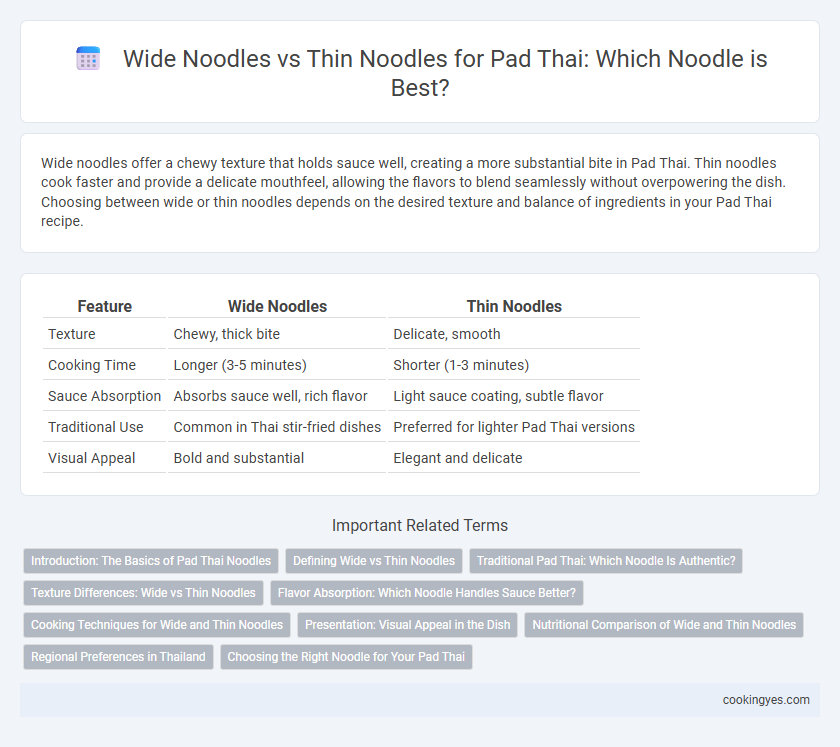Wide noodles offer a chewy texture that holds sauce well, creating a more substantial bite in Pad Thai. Thin noodles cook faster and provide a delicate mouthfeel, allowing the flavors to blend seamlessly without overpowering the dish. Choosing between wide or thin noodles depends on the desired texture and balance of ingredients in your Pad Thai recipe.
Table of Comparison
| Feature | Wide Noodles | Thin Noodles |
|---|---|---|
| Texture | Chewy, thick bite | Delicate, smooth |
| Cooking Time | Longer (3-5 minutes) | Shorter (1-3 minutes) |
| Sauce Absorption | Absorbs sauce well, rich flavor | Light sauce coating, subtle flavor |
| Traditional Use | Common in Thai stir-fried dishes | Preferred for lighter Pad Thai versions |
| Visual Appeal | Bold and substantial | Elegant and delicate |
Introduction: The Basics of Pad Thai Noodles
Pad Thai traditionally uses flat, wide rice noodles that provide a chewy texture and effectively absorb the sauce, creating a balanced flavor profile. Thin rice noodles can be substituted, but they tend to cook faster and offer a lighter mouthfeel, which may alter the dish's classic consistency. Choosing wide noodles preserves the authentic texture essential to the traditional Pad Thai experience.
Defining Wide vs Thin Noodles
Wide noodles used in Pad Thai typically measure about 1 centimeter in width, offering a chewy texture that absorbs sauces effectively, while thin noodles, often around 0.5 centimeters or less, provide a lighter, more delicate bite. Wide noodles hold up well to stir-frying and create a heartier dish, whereas thin noodles cook quickly and deliver a softer mouthfeel. The choice between wide and thin noodles significantly influences the dish's texture and overall flavor balance.
Traditional Pad Thai: Which Noodle Is Authentic?
Traditional Pad Thai is made with wide rice noodles, known as sen lek, which provide the perfect texture to absorb the iconic tangy tamarind sauce and balance the dish's flavors. Thin noodles, or sen mee, tend to cook too quickly and can become mushy, deviating from the authentic chewiness that defines Pad Thai. Authentic recipes emphasize the slightly flat, wide noodle to maintain the traditional harmony of taste and texture in every bite.
Texture Differences: Wide vs Thin Noodles
Wide noodles in Pad Thai offer a chewy, hearty texture that absorbs sauces well, enhancing flavor depth with each bite. Thin noodles provide a lighter, silkier mouthfeel, allowing for quick cooking and a delicate balance with other ingredients. The choice between wide and thin noodles ultimately influences the dish's texture profile, with wide noodles delivering robustness while thin noodles offer subtle tenderness.
Flavor Absorption: Which Noodle Handles Sauce Better?
Wide noodles absorb pad Thai sauce more effectively due to their larger surface area and slightly porous texture, allowing the flavors to cling better. Thin noodles, while quicker to cook, tend to absorb less sauce and may result in a milder taste experience. For optimal flavor intensity, wide rice noodles provide a more balanced and saucy bite in traditional pad Thai.
Cooking Techniques for Wide and Thin Noodles
Wide noodles for Pad Thai require a gentler stir-fry technique to prevent tearing, absorbing sauces more evenly due to their surface area, while thin noodles cook quickly, demanding precise timing to avoid overcooking and clumping. Soaking wide noodles longer before cooking ensures flexibility and tenderness, whereas thin noodles benefit from a brief soak and immediate stir-fry to maintain their delicate texture. Mastery of heat control and continuous tossing enhances the optimal texture of each noodle type in authentic Pad Thai preparation.
Presentation: Visual Appeal in the Dish
Wide noodles create a bold visual impact in pad Thai with their broad, flat surfaces that showcase vibrant sauces and garnishes more effectively than thin noodles. Thin noodles offer a delicate, intricate appearance, intertwining gracefully to highlight the dish's textural complexity. Both types enhance pad Thai presentation differently, emphasizing either striking color contrast or elegant detail.
Nutritional Comparison of Wide and Thin Noodles
Wide and thin noodles for Pad Thai differ in their carbohydrate and calorie content, with wide noodles typically containing slightly more calories and carbohydrates per serving due to their larger surface area. Thin noodles often have a lower glycemic index, promoting steadier blood sugar levels ideal for those managing glucose intake. Both noodle types provide minimal fat and protein, making the choice dependent on dietary goals related to calorie control and carbohydrate metabolism.
Regional Preferences in Thailand
Wide noodles are commonly favored in Central Thailand for Pad Thai, offering a chewy texture that pairs well with the region's sweeter, tangier sauce. In contrast, thin noodles dominate Pad Thai recipes in Northern Thailand, where lighter, spicier flavors complement their delicate consistency. Regional preferences in Thailand highlight these noodle variations, showcasing the diverse culinary landscape influencing Pad Thai's traditional preparation.
Choosing the Right Noodle for Your Pad Thai
Wide rice noodles offer a chewy texture and absorb the savory tamarind sauce well, enhancing the traditional Pad Thai experience. Thin rice noodles cook faster and create a lighter, more delicate dish, ideal for those who prefer subtle flavors and a less dense bite. Selecting the right noodle depends on whether you prioritize texture and sauce absorption or a lighter, more refined noodle structure in your Pad Thai.
Wide noodles vs thin noodles for pad Thai Infographic

 cookingyes.com
cookingyes.com